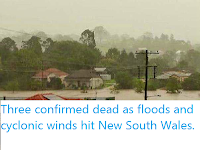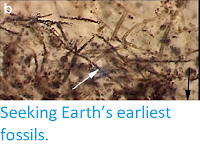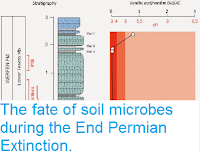Bryozoans, or Moss Animals, are colonial filter-feeding invertebrates
that form encrusting or weed-like colonies. The individual 'animals' are
on average about 0.5 mm in length, and live inside a protective
covering from which they extend a crown of cilia-covered tentacles
called a lophophore. These are not true individuals though as they
develop as buds on the colony and share nutrients; for this reason they
are referred to as 'zooids'. The colonies produce sexually by means of
reproductive zooids that have gonads, but lack feeding apparatus.
Bryozoans are widespread globally, but are often overlooked because they
are small and the colonies resemble plants.
In a
paper published in the
European Journal of Taxonomy on 31 August 2017, Björn Berling of the
Oberösterreichisches Landesmuseum, and the
Centro de Investigação em Biodiversidade e Recursos Genéticos,
Jean-Georges Harmelin of the
Mediterranean Institute of Oceanography at
Aix-Marseille University, and Beate Bader of the
Institut für Geowissenschaften at
Christian-Albrechts-Universität, describe ten new species of Bryozoas from the seamounts, islands, and continental slopes of the northeast Atlantic.
The first new species described is named
Atlantisina atlantis, in reference to the Atlantis Seamount, where it was found; it is considered to be sufficiently different from a previoulsy described Bryazoans to merit also being placed in a new family, the Atlantisinidae. This an encrusting Bryozoan, forming ribbon-like colonies by linear budding. It has a translucent frontal shield covered with densely packed irregular nodules, and six spines around its oral orifice. The species was found encrusting Coral skeletons at depths of between 275 and 460 m.
Atlantisina atlantis, Atlantis Seamount. Overview of colony growing on a Stylasterid skeleton; note the biserial-branching growth. Scale bar is 1 mm. Berling et al. (2017).
The second new species described is also placed in the genus
Atlantisina and given the specific name
meteor, in reference to the Great Meteor Bank, where it was discovered. This species is similar to
Atlantisina atlantis, but has a frontal shield covered in nodules with flattened tips and eight spines around its oral opening. This species was found encrusting shells, pebbles and fragments of Coral skeleton on the Grand Meteor Bank and the Irving and Hyères seamounts at depths of between 270 and 750 m.
Atlantisina meteor, Great Meteor Bank, several autozooids and ovicellate zooids. Scale bar is 300 μm. Berling et al. (2017).
The third new species described is again placed in the genus
Atlantisina, and given the specific name
inarmata, meaning 'unarmed' as it lacks a spike beneath its mouth opening, someting found in many species. The frontal shield of this species is porcelain white, and covered with flattened nodules, and it has six spines around its oral opening. This species was found growing on shells, pebbles and fragments of Coral skeleton around Gran Canaria in the Canary Islands, at depths between 345 and 485 m.
Atlantisina inarmata, Canary Islands. An autozooid with a borehole in the frontal shield (centre), presumably drilled by a predatory Microgastropod, and one with an intramural bud (at right), indicated by the presence of a secondary orifice rim. Scale bar is 100 μm. Scale bar is 300 μm. Berling et al. (2017).
The forth new species described is again placed in the genus
Atlantisina and given the specific name
seinensis, meaning 'from Seine', in reference to the Seine Seamount, where it was discovered. This species has a frontal shield with large flattened nodules, six oral spines and a plate with a large spike beneath the oral structure. The species was found encrusting rocks at a depth of 235–260 m.
Atlantisina seinensis, Seine Seamount. Lateral view showing the vertical dimensions of the suboral umbones. Scale bar is 200 μm. Berling et al. (2017).
The fifth new species described is again placed in the genus
Atlantisina and given the specific name
tricornis, in reference to the sub-oral plate, which has a triple spike. The frontal shield of this species has a pattern of raised ridges around polygonal depressions, and it has six oral spines. The species was found encrusting rocks, Brachiopods, and fragments of Coral and other skeletal elements at depths of between 450 and 1040 m on the Iberian continental slope and between 675 and 1700 m on Galicia Bank.
Atlantisina tricornis. Colony from Galicia Bank forming biserial ribbons; note the relatively broad ooecia. Scale bar is 300 μm. Berling et al. (2017).
The sixth new species described is once again placed in the genus
Atlantisina and given the specific name
lionensis, meaning 'from Lion' in reference to Lion Seamount, where it was discovered. The frontal shield of this species has a pattern of raised ridges around polygonal depressions, it has six oral spines, and a suboral plate with three-to-five irregularly shaped spikes. This species was found encrusting small rocks at depths of between 320 and 630 m, on the Lion and Seine seamounts.
Atlantisina lionensis, Lion Seamount. Ovicellate zooids at the colony growth margin. Scale bar is 100 μm. Berling et al. (2017).
The seventh new species described is once again placed in the genus
Atlantisina and given the specific name
gorringensis, meaning 'Gorringe' in reference to the Gorringe Bank, where it was discovered. This species has a small, frontal shield with a reticulate pattern of raised ridges encircling round to polygonal depressions, six oral spines and a suboral plate with up to eight spikes. This species was found encrusting small shells and pebbles at depths of 180 to 330 m, on Gorringe Bank and Ampère Seamount.
Atlantisina gorringensis, Gorringe Bank. Periancestrular region, the constricted oral region of the partly overgrown ancestrula is to the left. Scale bar is 300 μm. Berling et al. (2017).
The eighth new species is once again placed in the genus
Atlantisina and given the specific name
acantha, meaning 'thorny', in reference to its suboral plate, which is flared and has a variable number of large spikes. The species has a frontal shield with a reticulate pattern of raised ridges encircling round to polygonal depressions and six oral spines. It was found growing on small rocks at a depth of 660 m off the coast of Gran Canaria.
Atlantisina acantha, Canary Islands. Close-up of ooecium and the suboral crest. Scale bar is 100 μm. Berling et al. (2017).
The ninth new species described is named
Bathycyclopora suroiti, where '
Bathycyclopora' is a combination of 'bathyal', meaning 'deep' and '
Hemicyclopora', a previously described genus which it superficially resembles, and '
suroiti' in honour of French research vessel ‘Le Suroît’. This species has a frontal shield with pronounced ridges and seven or eight oral spines. It is an encrusting Bryozoan, with colonies forming patches with the individual zooids separated by grooves. This species was found on Atlantis Seamont at depths of 275–460 m, encrusting fragments of shell and Coral.
Baythycyclopora suroiti, Atlantis Seamount. Overview of a partly damaged colony. Scale bar is 100 μm. Berling et al. (2017).
The final new species described is named
Calvetopora otapostasis, where '
Calvetopora' in honour of the early twentieth century marine biologist Louis Calvet, for his work on Bryozoans, and '
otapostasis', meaning 'protuding ears', in reference to the two avicularia (modified zooids that are used as suplimentary mouthparts) on either side of the oral opening. This species has a frontal shield with a granular texture and six oral spines. It forms large, patch-shaped colonies, which sometimes overgrow themselves, and was found growing on fragments of coral skeleton at depths of 280 to 460 m on Atlantis Seamount.
Calvetopora otapostasis, Atlantis Seamount. Slightly oblique view of an autozooid at the growth margin showing the communication pores in the lateral walls as well as marginal areolar pores (black arrow) and the roughly crescentically arranged pseudopores (white arrows) in the frontal shield. Scale bar is 200 μm. Berling et al. (2017).
See also...




















































